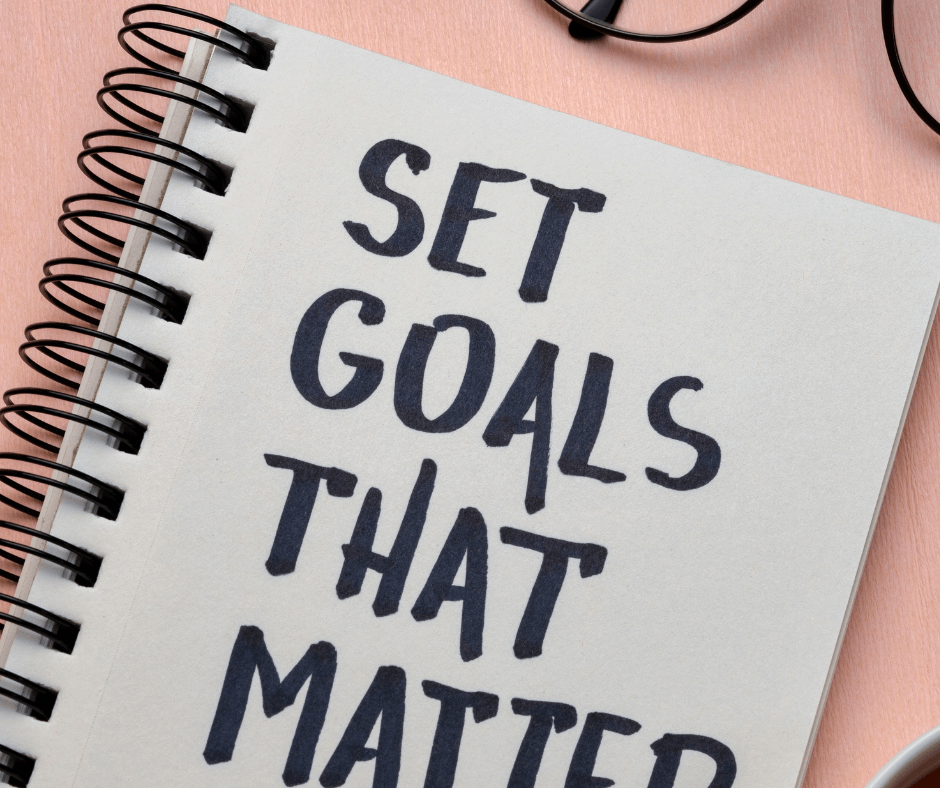What’s better, having a goal or creating a habit?
But aren’t they the same thing you may ask? No, they’re not. But you do need one for the other.
“Goals are often things that society or others set for us rather than being intrinsically or internally motivated by our own values, belief and interests.”
If your yearly goals are usually about improving fitness, eating healthier or losing weight, then you’re part of the 14 million Australians who do so according to the Finder’s survey.
“A goal is a dream with a deadline.”
Definition of a habit on the other hand is defined as
noun
a settled or regular tendency or practice, especially one that is hard to give up
an acquired behaviour pattern regularly followed until it has become almost involuntary
The habit is doing a workout every day, the goal is what you aim to achieve by completing set habits for example:
Doing a workout every day (a habit) will help you achieve a stronger body (goal).
Knowing what your goal is, helps you create those habits to achieve that goal. Makes sense?
For example, this year I am wanting to improve my back pain = goal. To do this I do stretches and strengthening exercises before climbing out of bed every morning = habit.
Habit helps you develop the discipline and consistency to achieve that goal.
Why set goals?
Goals determine what you to achieve in life.
They give laser focus on what’s important.
Having a goal helps us move forward in life.
Goals help us access where we are currently in our professional and personal lives.
Goals help you stay motivated.
Goal setting rewires your brain to make it more effective.
“Research in neuroplasticity suggests that goal-setting can change your brain’s structure to make it more effective at achieving a specific goal.”
“It’s the process of living with intention and letting life happen FOR us rather than TO us.”
So how do you know what goal to create a habit for?
Step # 1 - Begin with the end in mind.
Firstly, visualize the person you want to be.
What does that person look like?
Feel like?
What would excite you?
What does her confidence look like?
Write your answers down.
Step # 2 - What would you need to do to become that person?
Visualize the person and then align your thought pattern, mindset, and actions need to aligned with the person you want to become.
Questions to ask yourself:
Thought patterns and mindset - How should I talk to myself in order to reach that goal?
What do I need to do in order to become that person. What action do I have to take?
What habits must I attach to my goal, to become that person?
Decide on just one goal or one for each aspect of your life like -
family/home life,
relationships/friendships,
business/work,
intellectual,
spiritual,
fitness,
health,
financial and/or
community.
Step # 3 - Know your ‘Why.’
American author and inspirational speaker Simon Sinek talks about ‘Start with WHY to inspire action.”
Your ‘Why’ has to be stronger than just setting a goal.
When you know why you want to set your goal, you will be more inspired to work towards that goal with simple habits every day.
Your goal will only take you as far as achieving them, your ‘Why’ keeps you going long after.
For example, let’s say I want to set a goal to workout 3 times a week to look good for a wedding in a months’ time.
Setting a goal to work out just to look good for a wedding is not enough. Once the wedding comes and goes, then what. Do you stop exercising?
Your ‘Why” must be more than just aesthesis. It needs to be a deep-rooted reason why you want to achieve that goal. For instance:
‘I want to become fitter so that I can play with my kids or grandbabies’.
‘I want to exercise for my mental health; to reduce my anxiety and stress’.
‘I want to do strength training to increase my bone density.‘
‘I want to exercise today so that I can live an active, independent life with a strong heart and bones as I become older.’ (This is my personal WHY.)
Step # 4 - Write it down.
"Write it down. Written goals have a way of transforming wishes into wants; cant's into cans; dreams into plans; and plans into reality. Don't just think it - ink it!" - Michael Korda
Psychologist Gail Matthews’s study found that individuals who wrote down their goals were 33% more successful in reaching them than those who didn’t write them down.
When we write down our goals, we make them real and bring them to life.
Goals can be short-term or long-term.
Long-term goals:
Usually, achievable longer than a year
For example, an example of a long-term goal is writing a book in 2 years. Then create smaller goals to achieve that one large goal is broken down into daily goals of writing x number of words each day and x number of chapters per fortnight etc.
Short-term goals:
Achieved under a year.
Examples of short-term goals are increasing physical activities, starting Pilates,
When you write down your goal, your intention to achieve that goal becomes more laser focused.
When you choose your goal, make sure that your goals are what YOU want to do, not what you think you should be doing or what others tell you should be doing.
“The real value of setting and achieving goals lies not in the rewards you receive but in the person you become as a result of reaching your goals.”
Step # 4 - K.I.S.S it.
Keep it simple sweetheart. Don’t make it hard for yourself.
If you find all this goal stuff overwhelming, then only focus on one goal - The most important one.
Step 5 - Create S.M.A.R.T.e.r. goals.
You’ve heard of S.M.A.R.T. goals before, but have you heard of S.M.A.R.T.E.R. goal setting?
S is for Specific
Include specifics like ‘what, who, when, which, why and how.
What are you aiming for? What exactly do you want to achieve by doing this goal? Be very specific.
Who is involved in achieving this goal? Yourself, coaches, teacher, or partner.
When do you want to achieve your goal?
Which - what do you need to achieve this goal, which problems could arise during achieving this goal?
Why do you want to achieve this goal? Why are you doing it?
For example, rather than say I want to walk, be specific and say how long you want to walk daily, for example, use distance and time e.g. I will walk 30 minutes 3 days a week, or I will walk 2km daily.
How are you going to achieve this goal?
M is for Measurable or Meaningful
How will you know when you’ve achieved your goal/s?
Have some way that you can measure your progress towards that goal. Write down precise times, and amounts etc.
Include ‘how much, how many and or how fast.’
For example, every day after I have walked my 2km in x time, I will mark it off on my goal sheet or ‘I will drink 2 litres of water daily. You could also make the goal meaningful, that way you can measure a meaningful goal.
A is for Achievable or Attainable.
Write a goal that stretches and challenges you, but don’t make it unrealistic that could leave feeling discouraged and even give up.
How can you accomplish this/these goals?
Do you have the time and effort in reaching this goal?
Are you aware of the obstacles that could potentially derail you from reaching your goal?
R is for Realistic or Relevant
The goal should be something that you really want to achieve and that you could commit to doing.
The goal/s must seem worthwhile.
It has to be relevant to your life, in harmony with your life and circumstances, your core values and in line with what you truly want out of your life.
T is for Time-bound
When can you accomplish this goal/s?
Setting an exact date when you want to achieve your goal, marks an endpoint or deadline.
Without making your goals time-bound, you could faff around never achieving any goals or direction or progress in life.
When you have an endpoint, you can look at your goals on a daily, weekly or monthly basis and see how close you're moving towards your goal/s.
If you are a procrastinator, instead of making a goal for example 3 months away, create weekly goals that you can work towards.
E is for Evaluate
This is where we add onto S.M.A.R.T. goals and make them S.M.A.R.T.E.R.
Evaluating your goals every day makes them front of mind and thought, especially when your goals are longer than 3 to 6 months.
When you don’t evaluate them daily, you are less likely to achieve them.
This is where it is a good idea to make it a habit to evaluate your goals.
Do you remember when we mentioned writing your goals down? Now you can look at those goals and evaluate if they are still the most important focus in your life or if you are still working towards your goal.
See what’s working and what’s not. Then readjust …
R is for Re-adjust
Tweak your goals or habits if they do not serve you.
Plan for challenges along the way and extend the goal's deadline if needed.
If your situation changes, change or tweak your goals.
Life is constantly changing. If you find that your life’s circumstances change, tweak your goals accordingly.
Once you have evaluated your goal/s, readjust your goals or method or techniques that you’re using to achieve that goal. Try different approaches until you find one that best suits you and helps to propel you towards that goal.
“If the plan doesn’t work, change the plan, but never the goal. ”
Step # 6 - Place your written goal where it can be seen every day.
Else, what’s the point of writing them down? Out of sight, out of mind.
Revisited your goals daily - A great tip that I read about is to clip your goals onto your diary where you can see it daily.
If you find yourself overlooking the goal, change where your placement so that your brain doesn’t just use to see it and overlook it.
Step # 7 - Create systems.
“Our goals can only be reached through a vehicle of a plan, in which we must fervently believe, and upon which we must vigorously act. There is no other route to success.”
“You do not rise to the level of your goals. You fall to the level of your systems.”
A goal without a plan is just a dream. A plan without systems and routines is just wishful thinking.
Add a said goal to something you’re already doing (this is called anchor habits like brushing your teeth, sitting at your desk or making your morning coffee).
For example, if you want to strengthen your legs, then every time when you boil the kettle for tea/coffee, do 10 squats or when you brush your teeth, do 10 heel raises.
When you succeed in adding your little habit e.g., doing 10 squats, allow yourself a happy dance. This allows your brain to experience those feel-good hormones.
Step # 8 - Take baby steps.
Once you set your goals, many people stop there and do not write down the steps to achieve those goals on a daily basis..
A simple example is if you want to run a half marathon, by the end of the year, but have never run before, you need to break down running that marathon distance into tiny steps for example, “I will walk 2 minutes and then run 1 minute until I am able to run x km a day for x time, building up your distance over time.
This prevents injury, strengthens your tendons and ligaments and helps you become fitter strategically
Focus on the process of running x this week and then in 3 weeks increase the distance by 10%. These are feedback loops. They’re achievable and help you feel motivated and good about yourself, helping you to stay focused and gives you a sense of achievement.
Once you have your goal on paper, write out what you’ll need to get there. These are your subgoals and the resources that you will need to support you along the way.
Have clearly prioritized to-do lists, schedules, time frames for completing a task, and deadlines for goals to help counter procrastination.
Work back from your deadlines to know how long you need, and when to get started so you’re not late.
Focus on one task at a time.
“Wanting to change is step one, but step two is taking it.”
This is where the rubber meets the road. This is ‘how’ you’re going to meet your goals.
Develop small simple actionable steps that need to happen first, like having mini goals within the big goal. Map out a step-by-step process that needs to happen first before the next step.
Ticking off each step and seeing how far you’ve come, will inspire you to keep going and achieving more.
Step # 9 - Celebrate your wins.
This may sound lame, but as you reach small milestones within your goals, celebrate them.
It doesn’t have to be huge celebration, but just do it. Your mind will flood with happy hormones, and this will help you to carry on till the end.
So, there you have it. I do believe that you can’t have one without the other. What do you think?



















